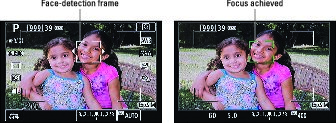In a group shot where more than one face is recognized by the camera, you see arrows on either side of the focus frame. To choose a different face as the focusing target, tap the face or use the Multi-controller to move the target frame over the face.

To lock focus on the face, press and hold the shutter button halfway down or press and hold the AF-ON button. When focus is locked, the focus frame turns green, as shown on the right above, and the camera emits a beep. (Disable the sound effect via the Beep option on Shooting Menu 1.) If focus isn’t successful, the focus frame turns red.
When the conditions are just right in terms of lighting, composition, and phase of the moon, this setup works fairly well. However, it has a number of “issues”:
- People must be facing the camera to be detected because the feature is based on the camera recognizing the pattern created by the eyes, nose, and mouth.
- The camera may mistakenly focus on an object that has a similar shape, color, and contrast to a face.
- Face detection sometimes gets tripped up if the face isn’t just the right size with respect to the background, is tilted at an angle, is too bright or dark, or is partly obscured.
- Autofocusing isn’t possible when a subject is very close to the edge of the frame. The camera alerts you to this issue by displaying a gray frame instead of a white one over your subject. You can always temporarily reframe to put the subject within the acceptable autofocus area, lock focus, and then reframe to your desired composition.

